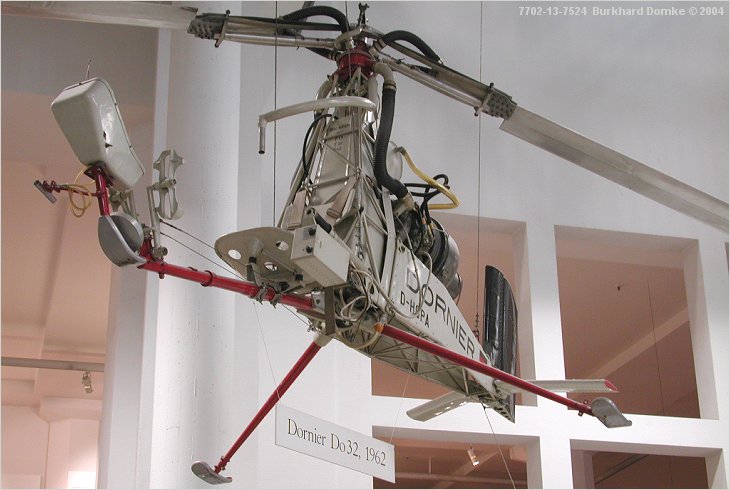
The Dornier 32 E/U was an ultra-light single seat helicopter designed by Dornier, which started flight testing at Oberpfaffenhofen on June 19, 1962. It was a collapsible helicopter with reaction drive which could be carried in a car trailer which also served as a take-off and landing platform. Stowed in a special transport box, the helicopter could be stored anywhere, ready for operation, and was easily carried by air, sea and land. The two-blade rotor made of light metal was driven by compressed air leaving through blade tip nozzles. The drive system of this reaction helicopter, free from anti-torque moment, consisted of a turbine-operated compressor made for easy handling in operation. The Do 32E was practically a precursor for the unmanned "Kiebitz" ("Pewit") rotor platform. The Do 32 U autostable, remotely controlled rotor platform was derived from the Do 32 single seat helicopter. This experimental unit was used from June 1966 for basic testing for the future tethered unmanned "Kiebitz" rotor platform.
Dornier built a total of three prototypes of the single-seat helicopter. Since the German Ministry of Defense (Bundesverteidigungsministerium) was in muliseater though, additional models were not completed.

The Dornier Do.32 was one of the first helicopters designed and built by the German helicopter industry after the war. It was a small, ultra-lightweight single-seater which could be carried in a container of modest size, measuring 3.8m long and less than 1m wide. The container was fitted with wheels, could be towed by an ordinary motor car, and also served as a take-off and landing platform. The mini helicopter could be assembled in just five minutes.
The Do.32 was powered by a 100shp BMW 6012 turbine which drove the rotor through a cold cycle. The prototype was tested on 29 June 1962 and completed the test programme in mid 1963, when the German company displayed a second model at the Paris Air Show. A few others were built but the two-seat derivative (with a 250shp turbine) offered to the German government was not adopted.
Information
Note: This information is for education purposes. Source of texts retained.
My own theory:
The yaw control is through the flow of air over rudder, as a conventional airplane.
In a hover, the exhaust from the turbine will provide that flow...just a theory.
cl12pv2s